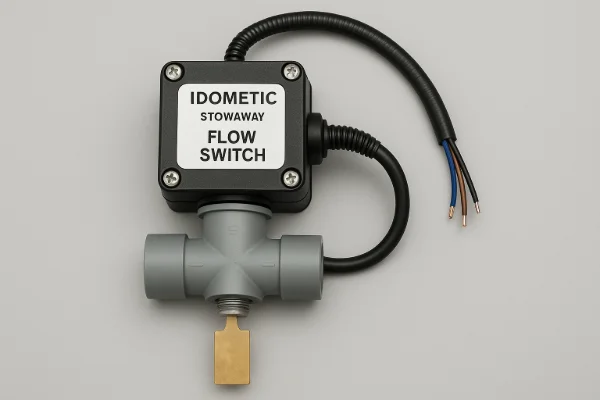Introduction
The Dometic Stowaway Flow Switch is an essential component for maintaining the safety and efficiency of marine and RV cooling systems. It monitors water flow and automatically shuts down air conditioning or chiller units when circulation stops, helping to prevent overheating and equipment damage. Whether you’re navigating open waters or traveling cross-country in an RV, this flow switch adds a layer of protection that can save you time, money, and stress. In this article, we’ll explore how the Dometic Stowaway Flow Switch works, its key benefits, installation tips, and why it’s a smart investment for any mobile cooling setup.
What Is a Flow Switch?
A flow switch is a sensor designed to detect the movement of liquid in a system. It acts as a safety mechanism, shutting down connected devices (like air conditioning units) when no water flow is detected. This prevents overheating or dry running of essential components.Flow switch – Wikipedia. This technology is widely used in HVAC, marine, and RV systems, where uninterrupted water circulation is essential for cooling operations.
Introducing the Dometic Stowaway Flow Switch
The Dometic Stowaway Flow Switch is specifically engineered for marine and recreational vehicle use. Its main role is to monitor seawater or coolant flow through systems like chillers, air conditioners, or refrigeration units. If the flow stops unexpectedly due to pump failure, a clog, or low water intake, the flow switch sends a signal to shut down the connected unit, preventing costly damage.
Why Marine and RV Systems Need a Flow Switch
1. Prevent Equipment Damage
In both boats and RVs, many systems rely on continuous water circulation for cooling. If that flow stops, systems can overheat quickly. A flow switch stops the system when water isn’t moving, protecting expensive gear.
2. Energy Efficiency
By halting operation when there’s no water flow, a flow switch also improves energy use. Your A/C or chiller won’t continue running pointlessly, saving power and reducing wear.
3. Enhanced Safety
In boats, overheating can lead to more than just mechanical failure—it can become a fire hazard. A flow switch ensures safer operation of onboard electronics and motors.
Technical Specifications of Dometic Stowaway Flow Switch
| Feature | Specification |
| Model Compatibility | Dometic Stowaway Series, Marine A/C systems |
| Flow Detection Threshold | ~0.75 gallons per minute (GPM) |
| Operating Voltage | 12V / 24V DC or 120V AC (model-dependent) |
| Contact Type | Normally Open (N.O.) |
| Pipe Connection Size | 3/4” or 1” barbed fittings |
| Material Construction | Corrosion-resistant thermoplastic & stainless steel |
| Max Operating Pressure | Up to 100 PSI |
| Operating Temperature Range | 32°F to 140°F (0°C to 60°C) |
| Weight | Approx. 0.6 lbs (272 grams) |
| Installation Orientation | Horizontal or vertical flow lines |
How the Dometic Flow Switch Works
The flow switch is installed inline on the water circulation line. Here’s how it operates:
- Flow Detected: When water is moving, the internal paddle or sensor remains in position, allowing the system to run.
- Flow Stops: If flow drops below a threshold, the paddle/sensor activates, breaking the circuit and shutting down the connected unit.
- System Shuts Down: The switch prevents operation until the issue is fixed and flow resumes.
It’s a simple concept, but one that provides vital protection for high-performance systems.
Key Features of the Dometic Stowaway Flow Switch
Compact & Easy to Install
Designed to fit into tight marine and RV spaces, its small size makes it versatile and convenient.
Corrosion-Resistant
Made with durable materials to withstand salty marine air, moisture, and vibration.
Reliable Activation
Triggers quickly when water flow stops, reducing the chance of system damage.
Compatible with Dometic Units
It integrates seamlessly with Dometic’s Stowaway chillers, air conditioners, and other cooling systems.
Comparison – Dometic Stowaway vs Other Flow Switches
| Feature | Dometic Stowaway Flow Switch | Groco FS-1 Flow Switch | Jabsco Pressure Sensor Switch |
| Designed For | Marine & RV systems | Marine systems | Marine water systems |
| Flow Detection Sensitivity | Moderate (0.75 GPM) | High (0.5 GPM) | Low (1.2 GPM) |
| Construction Material | Thermoplastic & stainless steel | Bronze & stainless steel | Plastic & rubber components |
| Power Compatibility | 12V/24V/120V (varies) | 12V/24V only | 12V DC |
| Best Use Case | Marine A/C, RV chillers | Engine cooling, seawater | Water pressure triggering |
| Manual Reset Required? | No | Sometimes | No |
| Corrosion Resistance | Excellent | Excellent | Moderate |
| Price Range | Mid-range | Higher | Budget-friendly |
When Should You Install One?
Consider adding a flow switch if:
- Your marine or RV cooling system doesn’t already have one
- You’ve experienced overheating, random shutdowns, or reduced water output
- You want to extend the life of your A/C, chiller, or water pump
- You plan to travel in remote locations where repair services are limited
How to Install the Flow Switch
While professional installation is always a good idea, many users choose the DIY route. Here’s a simplified overview:
- Turn off power and water to the system.
- Cut into the water line where the flow switch will be installed.
- Install the switch inline with appropriate clamps and fittings.
- Connect the wiring to the control unit per the manufacturer’s manual.
- Test the unit by running water and simulating a flow loss.
Always check Dometic’s official installation guide or consult a marine/RV technician.
Maintenance Tips for Long-Term Reliability
Even though the flow switch is largely self-sufficient, regular maintenance helps ensure peak performance.
Clean the Water Lines
Sediment and algae buildup can reduce flow. Flush the lines periodically to maintain smooth operation.
Inspect for Damage
Look for corrosion, loose wiring, or cracks—especially after long trips or storage periods.
Test Shutoff Function
Simulate a flow failure once or twice a season to confirm the switch works properly.
Real User Feedback
Sarah, Liveaboard Cruiser:
“My chiller shut off during a marina stay. The Dometic Stowaway Flow Switch flagged a blocked intake hose. I cleared it, restarted, and avoided major repairs. Worth every penny!”
Dave, RV Traveler:
“When we’re boondocking in summer, keeping the A/C safe is priority one. This switch gives me peace of mind that it won’t overheat if our pump fails.”
Ideal System Pairings
The Dometic Stowaway Flow Switch works best with:
- Dometic Stowaway Compact Chillers
- Cruisair and Marine Air systems
- Seawater cooling pumps
- RVs with rooftop or under-bed A/C units
- Generators or refrigeration systems that rely on water flow
Adding this switch as part of a complete cooling protection system ensures you’re covered from all angles.
What Does It Do?
The Dometic Stowaway Flow Switch detects when water stops flowing and shuts down your A/C or chiller to prevent overheating. It’s a small investment that can save thousands in repairs.
Conclusion
The Dometic Stowaway Flow Switch might not be flashy, but it’s one of the most important components in any marine or RV cooling setup. Whether you’re sailing offshore or exploring back roads, this smart little device works quietly in the background, offering constant protection. You’ve invested in quality equipment—don’t let a simple water flow issue bring everything to a halt. Add a flow switch, and travel with confidence.





